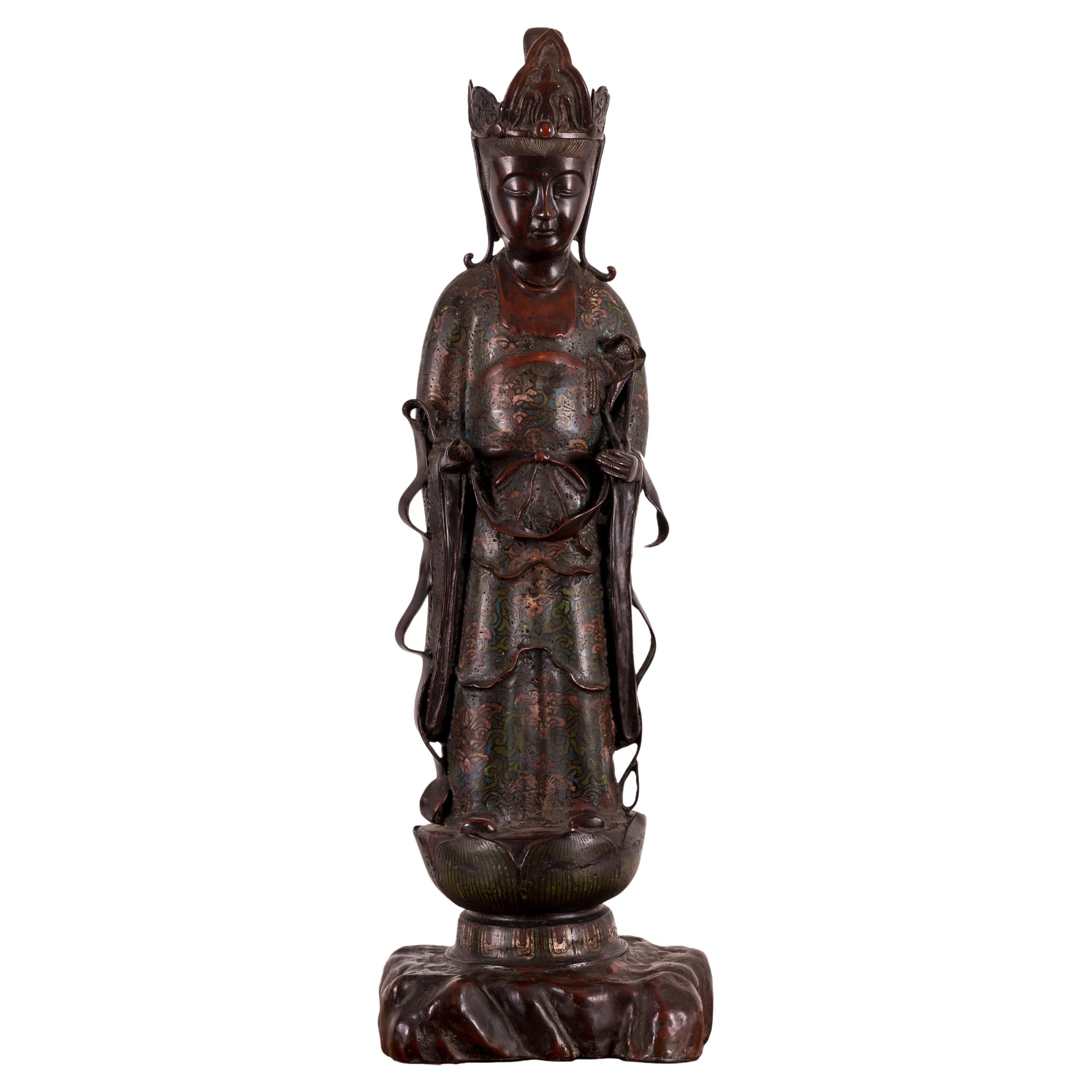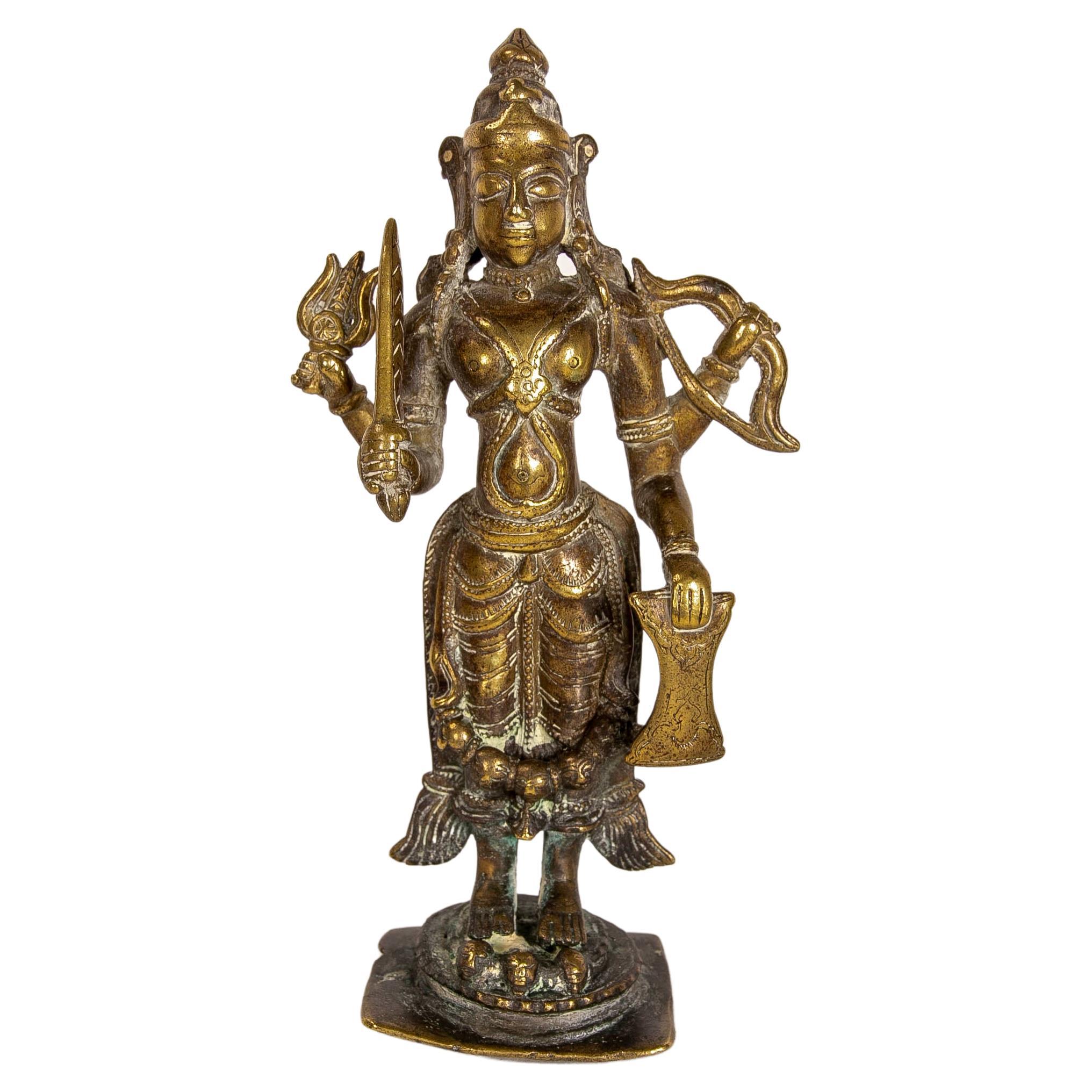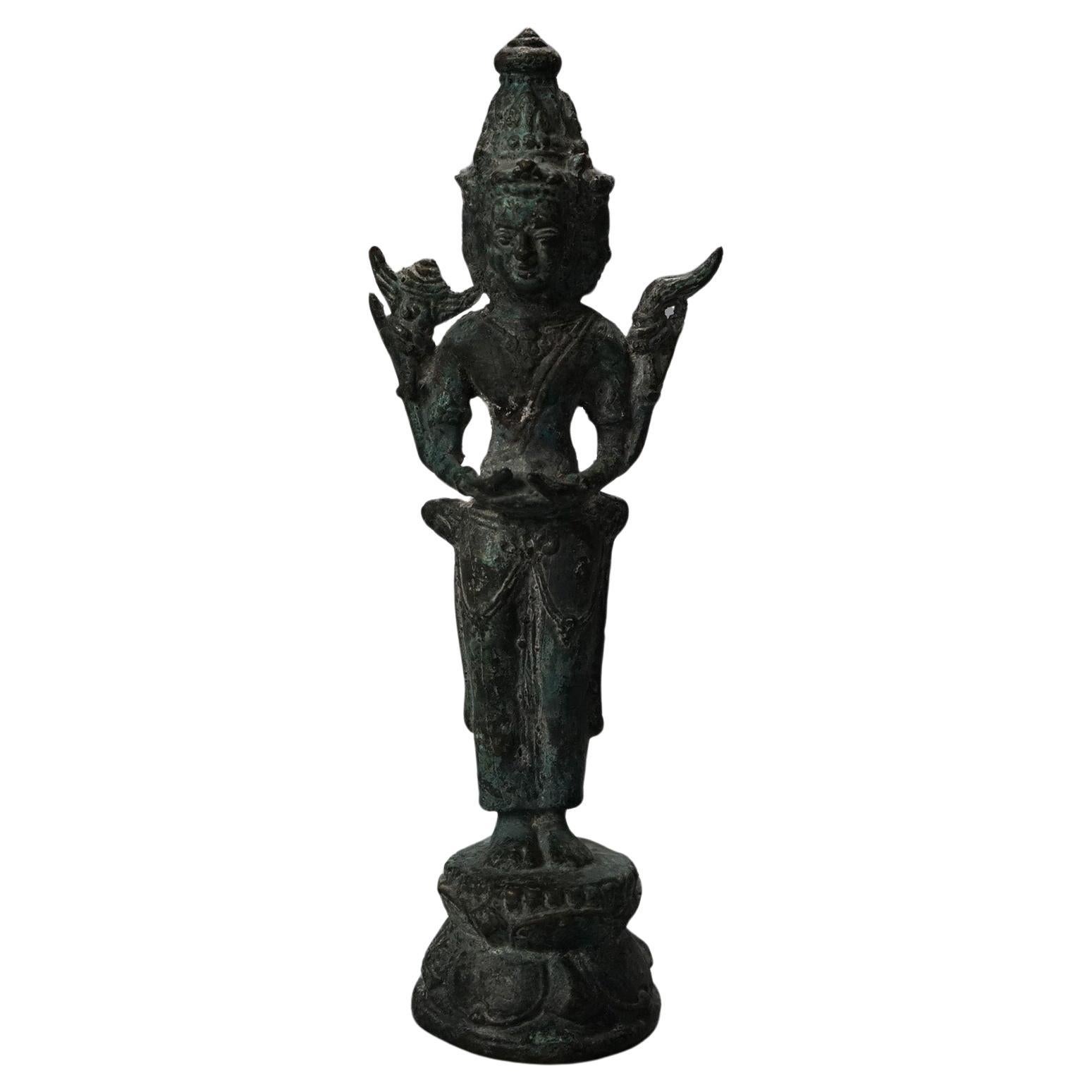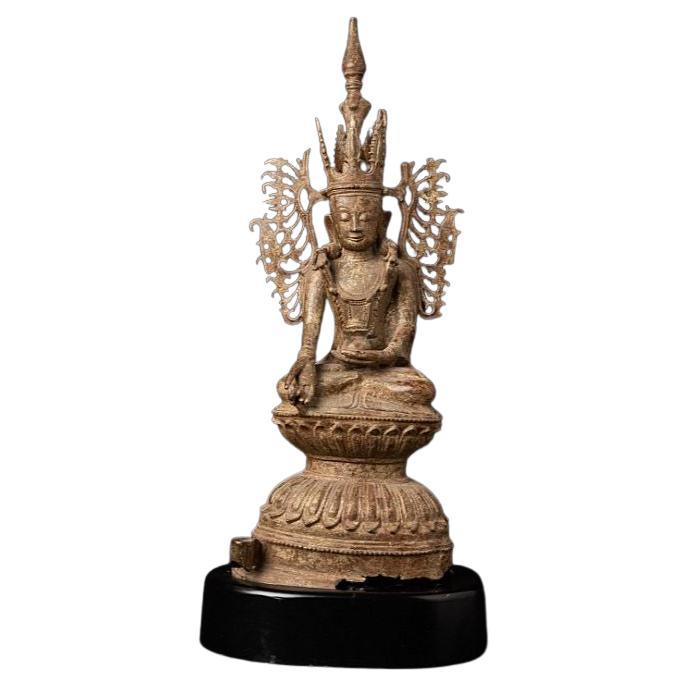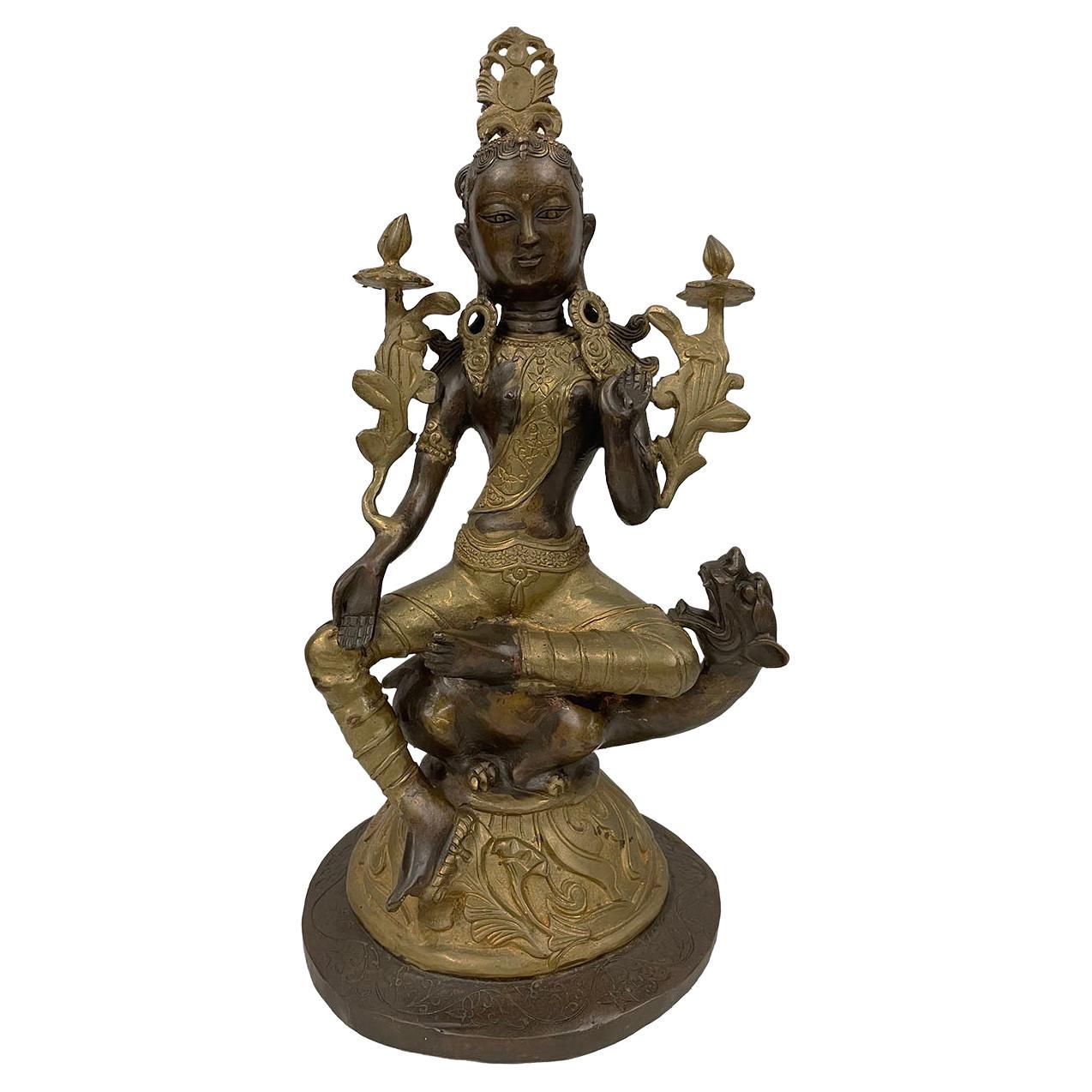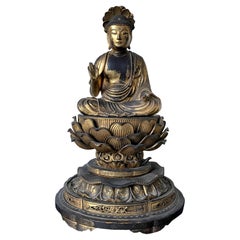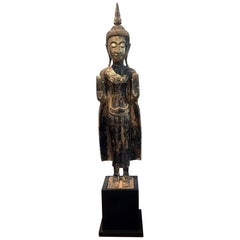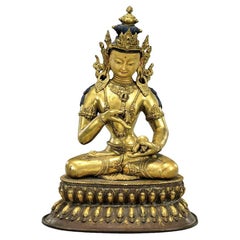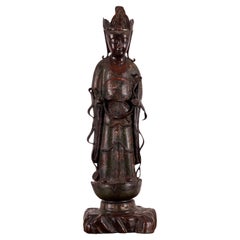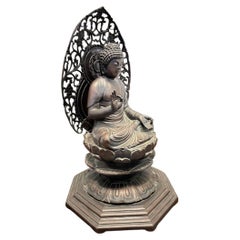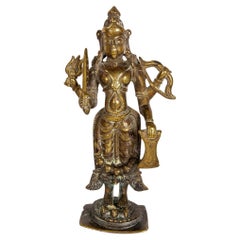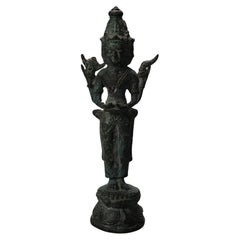Items Similar to Japanese Bronze Statue Nyoirin Kannon on Lotus Throne
Want more images or videos?
Request additional images or videos from the seller
1 of 21
Japanese Bronze Statue Nyoirin Kannon on Lotus Throne
$6,000
£4,507.37
€5,197.73
CA$8,325.78
A$9,251.78
CHF 4,848.03
MX$113,456.61
NOK 61,833.82
SEK 58,170.99
DKK 38,793.63
Shipping
Retrieving quote...The 1stDibs Promise:
Authenticity Guarantee,
Money-Back Guarantee,
24-Hour Cancellation
About the Item
A small and fine Japanese bronze statue of Nyoirin Kannon circa 18th century of Edo period. Kannon is bodhisattva of Mercy and Compassion (Avalokitesvara in Sanskrit and Guanyin in Chinese). The gilt bronze statue depicts one of the six variations of Kannon, knowns as Cintamanicakra in Sanskrit and Nyoirin Kannon in Japanese), sometimes known as the meditating Kannon. This variation was a wish-fulfilling form of the deity and was popular among the female worshippers.
Cast in one piece, the statue depicts the goddess posing in the iconic royal ease position on a double-lotus throne which symbolizes the Kannon's heavenly adobe. Dressed in robes with flowing ribbons, the bejeweled goddess dons a high chignon surrounded by a tiara-style crown known as Hokan in Japanese, on which a small Buddha was found in the center. The goddess has her left leg tucked flat on the pedestal and right leg half-folded to support her right arm. Her right hand nearly touched her face, suggesting a status of deep meditation. Her left hand raised to the chest level in mudra. The surface of the statue was gilt in a deep gold color, much of which still remains. The base of the statue is no longer sealed, revealing the patinated interior.
Nyoirin Kannon with two to four arms was a popular subject in Japanese Buddhism art and found in both paintings and sculptures. The small size of the statue makes it easily portable and suggests that it might be a personal worshipping item dedicated for private praying.
For other examples of bronze Nyoirin Statues, see item 2013.29.50 in the collection of Minneapolis Institute of Art.
A two-arm Nyoirin Kanon of gilt wood is in the collection of Metropolitain Musuem of Art in New York (56.39).
- Dimensions:Height: 7.5 in (19.05 cm)Diameter: 4 in (10.16 cm)
- Style:Edo (Of the Period)
- Materials and Techniques:
- Place of Origin:
- Period:
- Date of Manufacture:18th century
- Condition:Wear consistent with age and use. Minor losses. Overall good antique condition with patinated surface with marks and wears commensurate with age. Small holes on the left leg and also the top surface of the bases as shown.
- Seller Location:Atlanta, GA
- Reference Number:1stDibs: LU945039770762
About the Seller
4.9
Platinum Seller
Premium sellers with a 4.7+ rating and 24-hour response times
Established in 2006
1stDibs seller since 2010
564 sales on 1stDibs
Typical response time: <1 hour
- ShippingRetrieving quote...Shipping from: Atlanta, GA
- Return Policy
Authenticity Guarantee
In the unlikely event there’s an issue with an item’s authenticity, contact us within 1 year for a full refund. DetailsMoney-Back Guarantee
If your item is not as described, is damaged in transit, or does not arrive, contact us within 7 days for a full refund. Details24-Hour Cancellation
You have a 24-hour grace period in which to reconsider your purchase, with no questions asked.Vetted Professional Sellers
Our world-class sellers must adhere to strict standards for service and quality, maintaining the integrity of our listings.Price-Match Guarantee
If you find that a seller listed the same item for a lower price elsewhere, we’ll match it.Trusted Global Delivery
Our best-in-class carrier network provides specialized shipping options worldwide, including custom delivery.More From This Seller
View AllJapanese Antique Gilt Wood Amitabha Buddha on Loctus Throne Statue
Located in Atlanta, GA
A Japanese carved wood Amitabha (Amida) Buddha statue with residual gold leafed surface circa 19th century (late Edo period). The buddha is seated in the padmasana position on an elevated double lotus throne, under a small lotus halo canopy. His right hand is held in abhaya mudra which means fearlessness in Sanskrit. The mudra symbolizes protection, peace, and fearless. His left hand gently resting on his thigh. Dressed in a flowing robe with open chest, the statue showcases a classic iconography found prominently in Japanese Buddhism art during Edo to Meiji period, characterized by the double lotus throne and a particularly serene meditative facial expression, highlighted by inset gemstones...
Category
Antique 19th Century Japanese Edo Sculptures and Carvings
Materials
Gold Leaf
Antique Giltwood Buddha Statue Southeast Asia
Located in Atlanta, GA
A delicately carved wood Buddha in an upright standing posture with a double Abhaya mudra. The statue displays a gilt surface with beautiful patina and some minor wear. The face was ...
Category
Antique 19th Century Thai Other Sculptures and Carvings
Materials
Gold Leaf
Fine Sino-Tibetan Bronze Statue of Vajrasattva Bodhisattva
Located in Atlanta, GA
On offer is an impressively large and finely cast Sino-Tibetan gilt antiquebronze statue of Vajrasattva Bodhisattva, circa 19th century maybe earlier. The deity is depicted seating i...
Category
Antique 19th Century Tibetan Tibetan Sculptures and Carvings
Materials
Bronze
Antique Lopburi Buddha Statue from Thailand
Located in Atlanta, GA
The Buddha statue was made from a copper alloy in a standing position with hands in double Abhaya mudra. This mudra symbolizes the act of dispelling fear in the face of adversity. In Laos and Thailand where this mudra are used as one of the most iconic gestures, with its origin was pre-Buddhism era, when it was a symbol of good intentions and friendship when approaching strangers. In contrast to Indian iconography, it was often shown with both hands raised to the level of the shoulder in Southeast Asia. The statue was made in the classic Lopburi style, which historically was heavily influenced by Khmer art...
Category
Antique Late 18th Century Thai Other Sculptures and Carvings
Materials
Metal
Large Gilt Bronze Statue of Bodhisattva Avalokiteshvara with Four Arms
Located in Atlanta, GA
A finely cast bronze statue of Avalokiteshvara in his four-arm form with gilt and polychrome surface. The Bodhisattva of Infinite Compassion is worshiped in all Buddhism sect as one ...
Category
Antique 17th Century Chinese Qing Sculptures and Carvings
Materials
Bronze
Antique Japanese Carved Village Buddha Enku Style
Located in Atlanta, GA
A carved wood buddha with lacquered surface in the style of Erku (1632–1695), a monk from Edo period who was famous for hand-carving Buddha statues in a primitive style. From a single wood block of what appears to be cedar, the standing buddha was carved in an unpolished manner with exposed knife strokes that effectively depicted a subtly smiling face and the folding of the cascading robes. The rustic style is full of Mingei charm being a great example of Japanese Buddhism...
Category
Antique 18th Century Japanese Edo Sculptures and Carvings
Materials
Wood
You May Also Like
Japanese Meiji Champlevé Bronze Kannon Figure
Located in Savannah, GA
Japanese champlevé bronze Kannon Bodhisattva Avalokiteshvara figure, Meiji period.
9 ¾ inches wide by 8 inches deep by 29 ½ inches tall
Category
Antique Late 19th Century Japanese Meiji Sculptures and Carvings
Materials
Bronze
Japanese Large Old Bronze Seated Buddha , Kyoto Find
Located in South Burlington, VT
Japan, a fine large old seated Buddha, heavily hand cast bronze, with a fine medium to dark brown patina performing the mudra of compassion.
High quality, deep casting with fine ser...
Category
Mid-20th Century Japanese Showa Sculptures and Carvings
Materials
Bronze
1970s Bronze Sculpture of Buddha
Located in Marbella, ES
1970s Bronze Sculpture of Buddha.
Category
Late 20th Century Asian Figurative Sculptures
Materials
Bronze
Antique Cast Bronze Tibetan Buddha Shiva Figure 19thC
Located in Big Flats, NY
Antique Cast Bronze Tibetan Buddha Shiva Figure 19thC
Measures - 8.75"H x 3.25"W x 2.5"D
Category
Antique 19th Century Asian Metalwork
Materials
Bronze
$280 Sale Price
20% Off
Special Antique Bronze Burmese Buddha Statue from Burma
Located in DEVENTER, NL
Material: bronze
48,5 cm high
22 cm wide and 15,5 cm deep
Weight: 5.632 kgs
With light traces of 24 krt. gilding
Ava style
Varada mudra
Originating from Burma
16th Century
...
Category
Antique 16th Century Burmese Sculptures and Carvings
Materials
Bronze
20th Century Antique Tibetan Bronze Bodhisattva Tara Statuary
Located in Pomona, CA
In Buddhism, Tara is a savior deity (savioress) who liberates souls from suffering. She is recognized as a Bodhisattva in Mahayana Buddhism and as a Buddha and the mother of Buddhas in Esoteric...
Category
Early 20th Century Tibetan Tibetan Sculptures and Carvings
Materials
Bronze
More Ways To Browse
Forms Surfaces Bronze
Antique Bronze Statues
Antique Bronze Color
Antique Thrones
Small Antique Statue
Bronze Seal
Japanese Bronze Sculptures
Statue On Pedestal
Goddess Statue
Bronze Female Statues
18th Century Bronze China
Small Bronze Statues
Bronze Deity
Small Buddha
Chinese Bronze Statue
Antique Japanese Statues
Antique Tiaras
Edo Period Bronze
